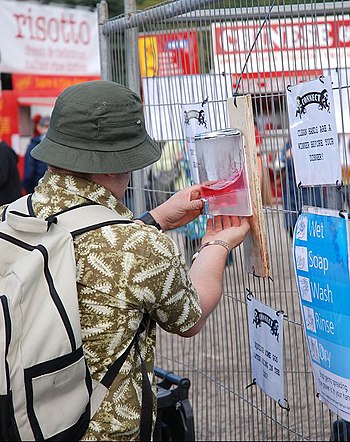National Health Surveillance Survey
To counter trend, HPB emphasises hip and cool tobacco-free lifestyle
Alicia Wong, alicia@mediacorp.com.sg

THE graphic images of tar-coated lungs and diseased mouths have helped cut smoking for some years, but it appears they are having less of an impact now, with the latest survey showing the first rise in the national smoking rate in 15 years.
So the Health Promotion Board (HPB) is shifting to a more positive tack by highlighting the benefits of a tobacco-free lifestyle. And it is targeting its message especially at young people, among whom there has been a huge jump in those taking up smoking. These younger smokers are typically less affected by the gory images.
Smoking among young men — those aged 18 to 29 — jumped sharply to 25.4 per cent in 2007 from 18.2 per cent in 2004, according to results released yesterday of the HPB's National Health Surveillance Survey. Among the women in the same age group, 9.1 per cent smoked in 2007 compared to just 6.6 per cent in 2004.
While the number of older smokers dropped modestly, the sharp rise in the number of young people smoking contributed to a one-percentage-point increase in smokers aged 18 to 69 in 2007 from 2004's 12.6 per cent. This was the first increase since 1992, when 18.3 per cent of those in this age range smoked.
"Previously we focused on the adult population because they had the biggest number of smokers," said HPB chief executive Lam Pin Woon, "We can identify that the slight uptake from 2004 to 2007 was due to the increase in youth (smokers)."
According to the survey, the top three reasons given by young people for smoking were: To cope with stress, they were addicted and "out of habit". Most started experimenting with tobacco at 16.
Mr Lam acknowledged that warning young people of the long-term harmful effects of smoking would be largely futile as the message would not "resonate with them". And "the more you try to use the law, the more they will rebel against it," he said.
So, the National Smoking Control Campaign 2009 — themed "Live it up without lighting up" and aimed at the younger smokers — will show that a tobacco-free lifestyle is hip and cool. The campaign emphasises the short-term benefits of not smoking, such as staying fit, looking good and having more cash in the pocket.
The three-month-long campaign, which started last month, features various events such as a T-shirt design contest, a fashion event and a hip hop competition.
The HPB is also enhancing its National Smoking Control Programme. From Friday, those aged below 18 caught smoking will be put through a mandatory online counselling course to encourage them to quit. For young working adults who want to kick the habit, the HPB will offer voucher redemption opportunities.
From TODAY, News – Wednesday, 29-April-2009
To counter trend, HPB emphasises hip and cool tobacco-free lifestyle
Alicia Wong, alicia@mediacorp.com.sg

THE graphic images of tar-coated lungs and diseased mouths have helped cut smoking for some years, but it appears they are having less of an impact now, with the latest survey showing the first rise in the national smoking rate in 15 years.
So the Health Promotion Board (HPB) is shifting to a more positive tack by highlighting the benefits of a tobacco-free lifestyle. And it is targeting its message especially at young people, among whom there has been a huge jump in those taking up smoking. These younger smokers are typically less affected by the gory images.
Smoking among young men — those aged 18 to 29 — jumped sharply to 25.4 per cent in 2007 from 18.2 per cent in 2004, according to results released yesterday of the HPB's National Health Surveillance Survey. Among the women in the same age group, 9.1 per cent smoked in 2007 compared to just 6.6 per cent in 2004.
While the number of older smokers dropped modestly, the sharp rise in the number of young people smoking contributed to a one-percentage-point increase in smokers aged 18 to 69 in 2007 from 2004's 12.6 per cent. This was the first increase since 1992, when 18.3 per cent of those in this age range smoked.
"Previously we focused on the adult population because they had the biggest number of smokers," said HPB chief executive Lam Pin Woon, "We can identify that the slight uptake from 2004 to 2007 was due to the increase in youth (smokers)."
According to the survey, the top three reasons given by young people for smoking were: To cope with stress, they were addicted and "out of habit". Most started experimenting with tobacco at 16.
Mr Lam acknowledged that warning young people of the long-term harmful effects of smoking would be largely futile as the message would not "resonate with them". And "the more you try to use the law, the more they will rebel against it," he said.
So, the National Smoking Control Campaign 2009 — themed "Live it up without lighting up" and aimed at the younger smokers — will show that a tobacco-free lifestyle is hip and cool. The campaign emphasises the short-term benefits of not smoking, such as staying fit, looking good and having more cash in the pocket.
The three-month-long campaign, which started last month, features various events such as a T-shirt design contest, a fashion event and a hip hop competition.
The HPB is also enhancing its National Smoking Control Programme. From Friday, those aged below 18 caught smoking will be put through a mandatory online counselling course to encourage them to quit. For young working adults who want to kick the habit, the HPB will offer voucher redemption opportunities.
From TODAY, News – Wednesday, 29-April-2009















































